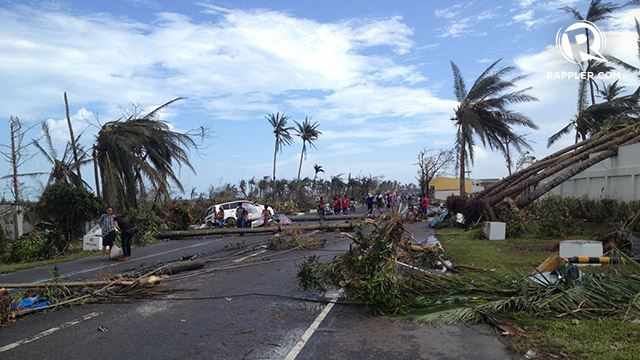SUMMARY
This is AI generated summarization, which may have errors. For context, always refer to the full article.

MANILA, Philippines – Super Typhoon Haiyan’s (Yolanda) devastating assault on the central Philippines exerted a catastrophic human cost, but analysts say its impact on one of Asia’s fastest-growing economies will be less traumatic.
More than 4,000 people were killed and up to 4.4 million displaced – twice the number that lost their homes after the 2004 Indian Ocean tsunami.
According to the International Labor Organization, around 5 million workers – equivalent to the population of Norway – had their livelihoods temporarily or permanently destroyed.
Risk modeling specialists such as AIR Worldwide have forecast the total economic loss at anywhere between US$6.5 billion and $15 billion.
(READ: Yolanda losses may reach $15B – report)
But as grim as those statistics are, the macroeconomic cost of Typhoon Haiyan, according to initial estimates from various sources, will be lighter than might have been expected from a storm of such destructive power.
The typhoon barreled through some of the poorest regions in the Philippines, sparing any significant manufacturing base and largely impacting agricultural areas producing rice and coconut.
“The affected areas account for a relatively small proportion of GDP, so the impact on headline GDP is likely to be small and manageable,” Credit Suisse said in a report that questioned forecasts suggesting Haiyan would shave one percentage point off the 2013 annual growth rate.
(READ: Yolanda to cut PH growth – NEDA)
“Exports of agricultural products will be impacted, but they form a relatively small portion of overall exports,” the report said.
The Philippine economy has been on an upswing for the past 5 years and expanded 7.6% in the first half of 2013 – a remarkable turnaround for a country once seen as an irredeemable non-achiever.
The government targeted gross domestic product (GDP) growth of between 6% and 7% for the whole year. It was confident it could surpass this target before Haiyan struck.
Growth goals still achievable
There is some concern over a spike in inflation triggered by higher rice prices, but most estimates predict it would be short-lived, especially if enough rice seed is provided for the crucial December-January planting season.
The Philippine central bank has indicated it would consider tweaking monetary policy if the typhoon’s inflationary legacy persists, but said economic growth goals for the year were still achievable.
“Our own runs (projections) show that 2013 GDP growth could still be within the government’s target range, as rehabilitation efforts could make up for lost production,” bank governor Amando Tentangco told the Wall Street Journal.
Reconstruction a silver lining
Economists such as Ronald Mendoza, executive director at the Asian Institute of Management in Manila, believe the reconstruction effort could prove to be the silver lining in the Haiyan story.
“There is a real opportunity here to encourage inclusive growth in a historically impoverished region that has been largely disconnected from those elements driving the national economy,” Mendoza said.
“An ambitious rebuilding program would not just be good for the region. It would also send an important message to foreign investors about the country’s resilience and its ability to bounce back from crisis,” he added.
The Philippines reached an important milestone this year as, one after the other, the 3 global rating agencies granted the country investment grade status.
The move reflected higher growth, political stability and improved governance – all of which have stimulated the interest of overseas investors.
The Credit Suisse report said the post-Haiyan reconstruction effort would boost GDP in 2014, and it also forecast a short-term shot in the arm for the country’s current account delivered by a spike in overseas remittances.
The amount of money Filipinos living abroad send home every year is equivalent to 10% of GDP and previous disasters have traditionally seen a sharp jump of up to 15% in the size of the remittances.
But even the best-case economic scenario envisages a long, grim struggle for the millions of traumatized victims of Haiyan, for whom silver linings offer little immediate relief.
“Beyond the estimates of damage and reconstruction, it is important to consider the intangible losses,” said Danilo Israel, senior research fellow at the Philippine Institute for Developmental Studies.
“The loss in human lives, the loss of bio-diversity, the destruction of heritage sites, the loss of relationships – it’s difficult to put a value on these intangibles, which can sometimes have a big impact on economic growth.” – Agence France-Presse, with Rappler.com
Add a comment
How does this make you feel?
There are no comments yet. Add your comment to start the conversation.